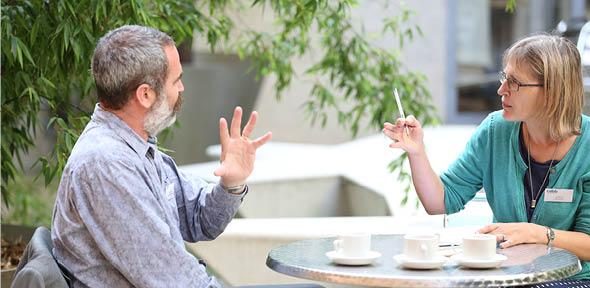
Submitted by Angela Walters on Tue, 24/09/2019 - 13:10
A mysterious figure was spotted at every single event during CDBB week. Who was he, the CDBB team wanted to know, and what was he doing here?
We tracked him down at the Summer Showcase and unmasked him as Professor Robert Amor, Head of the Department of Computer Science at the University of Auckland, New Zealand. Naturally, we wanted to ask him a few questions.
What’s your interest in the Centre for Digital Built Britain?
The New Zealand government has funded a seven-year, NZ$12.5 million industry-academic alliance to make productivity improvements in our construction industry (Building Innovation Partnership). I’m in charge of one of its three themes – on digital innovation – which has been set a pretty much identical task to the one given to CDBB. Hence, my interest.
Would you say that the UK and New Zealand are facing similar challenges?
Very much so, except, perhaps, in one important regard. We have about ten per cent of CDBB’s funding. Our population is roughly ten per cent of yours, so that kind of makes sense. But New Zealand and the UK have the same land area which means we need the same amount of infrastructure – but with less money and fewer resources to invest in it. So we have to be smart, learn from others, take what they have done and use that to step up from. The UK tends to be our first port of call, as our industry structures are largely similar to yours which makes it easy to translate your initiatives into our environment.
Where is New Zealand on its digital journey?
We definitely have a perception that we are behind. But it’s interesting. We’ve been on study tours through Asia, America and Europe and we’ve found that their leading companies are way ahead, doing amazing cutting-edge work and integrating it back into their practice in a way that’s beyond anything we have back home. Having said that, the overwhelming majority of their companies are in a similar position to ours: SMEs everywhere seem to be in the same boat.
Because we have fewer big companies able to take the risk of doing their own research, most of the innovation is happening through alliances with academic institutes, supported by government. And we are very good at looking for help in bringing about change, seeing what has worked in the UK and elsewhere and bringing it across. For example, we asked BRE to come to New Zealand to deliver its BIM 101 training. We then adapted it and now do our own, which meant it took us two months instead of a year to develop the programme. And that’s why I’m here: to see what other opportunities there might be for that kind of tech transfer.
What has particularly caught your eye during CDDB week?
The National Digital Twin Day. The London City Digital Twins project really appealed to me. All the digital twins they are developing are designed to answer a specific question.
We’ve had this dilemma in New Zealand: should we create the digital twin infrastructure and pull in all the data and let people discover what they can do with it in the hope that good things will come? Perhaps that would lead to better outcomes in the long run but there’s no guarantee that it’s going to give you anything useful in the next one, two or three years. What London is doing is very near-term and we could see that it will result in benefits very quickly. Identifying the question and delivering something which answers it, is going to be a good path for us to follow.
The other key takeaway from the day was the Gemini Principles. We need to make sure they are embedded in the digital twin work we are doing.
What about projects at the Summer Showcase? Anything of interest there?
Definitely! Some of the projects are of real interest and are very much aligned with our thinking. In particular, we have two projects underway on automated code-compliance checking. The D-COM Network and the work Professor Patricia Tzortzopoulos and her group doing are both very relevant to those, so we need to make sure that we are learning from what they are doing and vice versa.
I’ve talked to both of those teams. That’s one of the main benefits of events like this. It brings together a lot of the research leaders as well as industry and government.
What about inspiration for new projects?
There’s a lot going on and I guess that’s part of the CDBB strategy. Because we don’t have as much resource, we will probably narrow our focus to fewer areas. We’ll use CDBB’s capability framework to see what the UK thinks is important in the short, medium and long term, look at the areas we think will best translate to New Zealand and decide which ones we want to partner with industry to take forward.
Is CDDB Week now a regular fixture in your calendar?
I will definitely try to come again. It’s great having that concentration of all the right people in one place. In the meantime, I’m looking forward to keeping up all those useful connections I’ve made this time round.
Contact: Professor Robert Amor, University of Auckland
Maths & Physics Building, Room 401
School of Computer Science
University of Auckland
Private Bag 92019
Auckland 1142
New Zealand
Email: trebor@cs.auckland.ac.nz
